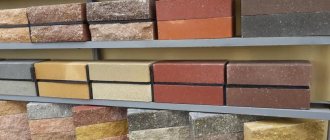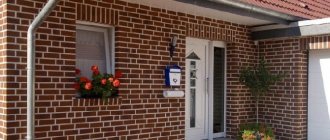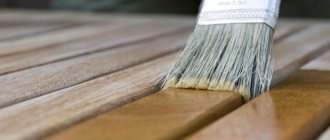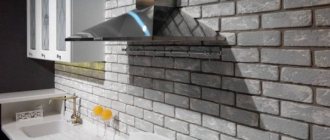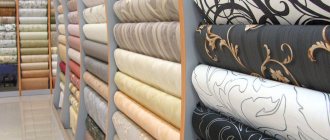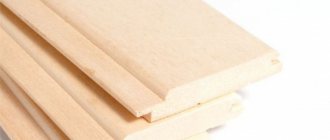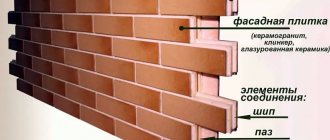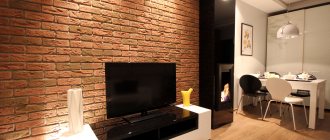Facades made of facing bricks invariably attract admiring glances. Every developer knows: it’s not enough to build strong walls. They need to be finished with such a material that it helps to obtain triple benefits at once: insulate, strengthen and decorate the building. These requirements are fully met by facing bricks. It is able to reliably protect external walls and increase their load-bearing capacity.
Facade facing brick
Types of facing bricks
Bricks intended for finishing facades are called differently:
- facing;
- façade;
- facial.
All this is the same material, which has the properties necessary for high-quality finishing of the building. These stones are used to build the outer layer of the wall, which is in direct contact with the environment and experiences all its adverse effects. Therefore, special requirements are imposed on the technical characteristics of these products.
Depending on the type of materials used in manufacturing and the production method, several types of facing bricks are distinguished:
- clinker;
- ceramic;
- hyper-pressed;
- silicate.
These products have different performance characteristics, but there is one thing in common: they can all have a traditional parallelepiped shape or a curly one. The second type of bricks is called shaped bricks. Each option has its own production standards, which all manufacturers adhere to.
Types of facing bricks
Traditionally shaped bricks are:
- single;
- one and a half;
- thickened;
- double.
Each of the listed products can be solid or hollow (hollow). Stones of the second type can have different shapes of holes and different numbers of them.
Shaped bricks impress with their impressive appearance. With the help of these building stones you can realize the most original ideas of architects and designers.
Shaped facing brick
Manufacturers offer the following types of shaped bricks:
- trapezoidal in shape with beveled ribs;
- twisted;
- wedge-shaped;
- with a textured front surface (like chipped or natural stone).
The spectacular appearance of figured stones largely depends on the method of decorative processing of their surfaces.
Three technologies are used:
- glazing;
- torqueting;
- engobing.
Engobed bricks are more suitable for cladding the facade of a residential building. They have a matte surface and, due to the production method, have a lower thermal conductivity coefficient. The engobing technology involves applying an additional layer of clay to the raw stone. It is this that makes the product “warmer”.
Angobed bricks
Glazed bricks have a glossy surface. The color range of such stones is very wide. Glazing can be applied in two ways: on the raw material or on the finished product. Regardless of the technique, the quality and appearance of the product will be the same.
Glazed bricks
Torquetting is the process of applying mineral chips to the front surface of a brick. After firing, the product acquires a beautiful relief texture. Such stones are often used to emphasize the architectural elements of a building: arches, entrance lobby, window openings, cornices.
Ceramic brick shotcrete with mineral chips.
Varieties by shape
The shape of products and surface texture influence the resulting design of buildings or objects. There are shaped and textured types.
Shaped
(shaped) brick is made in special shapes and can have rounded parts, a trapezoid, a wedge shape. It is used when finishing walls around window or door openings, and for laying arched transitions. Twisted shaped bricks are used for the construction of original columns and pillars.
Textured
the appearance may have completely smooth sanded surfaces or untreated edges (torn planes). The most popular variety is considered to be facade bricks with rolled surfaces: they are given the texture of stone through a larger protrusion of the central part and uneven transitions along the perimeter of the edge. Based on the photo of textured brick, you can choose the type that is suitable for the restoration of ancient buildings or the stylish finishing of new buildings.
Pros and cons of clinker bricks
Clinker is one of the best representatives of facing bricks. It has excellent interdependent characteristics such as water absorption and frost resistance. These stones can withstand up to 300 freeze-thaw cycles (frost resistance coefficient F300). But the thermal conductivity is quite high: 0.7 W/(m*°C). Durability – at least 100 years.
Among the features of this material is the duration of its laying. This is due to the low water absorption coefficient. The stone slowly absorbs moisture from the mortar, so working with it requires a certain skill.
Production of clinker bricks
The disadvantages of this material include the fact that even in one batch of clinker bricks there are often products of different shades. This significantly complicates the masonry process and increases construction time. Workers have to select stones of identical color and most beautifully distribute those with a darker shade on the wall.
Clinker bricks require laying with special mortars. The cost of these compositions is high, as is the price of the material itself. It is possible to lay it on cement-sand mortar, but you need to know the recipe for preparing the mixture and be able to work with it. Clinker bricks “float” with regular mortar.
Price for clinker brick
Clinker brick
Plaster for external use
A classic finish that has been used for many centuries. For plastering facades, solutions of cement and sand or lime are used. The coatings are strong, resistant to destruction and moisture. The solutions adhere well to any base - brick, concrete, wood. Plastered facades are coated with paint for exterior use, which gives free rein to the artist’s imagination: the wall can be given any shade, color combinations can be made.
Application
Plastering is often carried out with additional insulation of the facade. During such work, slabs or mats of heat-insulating material - mineral wool or penoplex - are attached to the outer wall. For ease of adhesion and strengthening of the layer, a reinforcing mesh is pulled over the insulator. Next, apply a plaster solution up to 5 cm thick.
Cladding with a cement-sand composition can be done without insulation. If a small layer of plaster is planned, the mesh is not used; to improve the adhesion of the materials, small notches are made on the wall.
Pros and cons of ceramic facing bricks
Ceramic brick comes in a variety of shapes and colors. The undoubted advantage of these products is environmental friendliness. At first glance, these stones look fragile due to the large number of voids. But this is a misleading impression. Ceramic bricks are highly durable.
Places of application of facing ceramic bricks
The main disadvantage of these stones is errors in the geometry of the shape. This complicates the laying process, since it is necessary to check the size of the stones. Another drawback is inclusions of limestone, which subsequently absorb moisture and begin to stand out on the surface of the wall with their more saturated color.
Price for ceramic brick
Ceramic brick
Pros and cons of hyperpressed bricks
The composition of hyperpressed brick includes shell rock, cement, and special additives.
Advantages of this type of stones:
- perfectly smooth geometric shape;
- identical sizes of all products of the same type;
- variety of colors;
- flexibility in processing (easy to saw);
- high strength 150-300 kg/cm2;
- water absorption 5-6%;
- frost resistance F150;
- wide range of shaped models.
Hyperpressed brick has virtually no disadvantages. The disadvantages include the heavy weight (4.2-4.4 kg), which affects the cost of transportation and the complexity of masonry.
Hyperpressed brick
Price for hyperpressed brick
Hyperpressed brick
Pros and cons of sand-lime facing bricks
Sand-lime brick is distinguished by its regular shape and high strength. The advantages of this facing material include the ability to withstand high temperatures, ease of processing, high sound insulation characteristics, and reasonable price.
Flaws:
- high thermal conductivity, which increases with humidification;
- heavy weight (single 3.3-3.6 kg, one and a half - 4-4.3 kg);
- monotony of colors;
- high moisture absorption coefficient;
- lack of shaped models.
Sand-lime brick
Price for sand-lime brick
Sand-lime brick
Should I buy hollow façade bricks?
The peculiarity of most affordable stones of this type is that they have the maximum possible number of voids. This is due to the peculiarities of manufacturing technology and the desire of manufacturers to save money. For the same purpose, they (manufacturers) often make only two edges of the product front: one spoon and one butt. But such a decision is justified, since the stone faces outward with only one side. The dimensions and shape of the voids can be different, and accordingly, the weight of the bricks is also different.
The facing layer is usually thin. Since behind it there is a stone with a porous structure with many voids, the front layer does not receive enough heat from it and is often supercooled. This leads to the appearance of microcracks. Water penetrates into them, which periodically freezes and thaws. Wind and sun rays contribute to the destruction process. All this leads to sad consequences for the building. Therefore, you can often see facades whose front bricks are partially destroyed.
Europeans were the first to understand the unprofitability of such building stones. They decided to halve the width of the product and strengthen its facing layer. This material is today called “Eurobrick”.
What's good about it? The small width (2 times smaller than that of a standard stone) allows it to freeze less often. The adjacent wall transfers heat and thereby helps stabilize the temperature of the cladding layer.
Hollow brick
We conclude: when choosing a hollow facing brick, you must first of all pay attention to the thickness of its wall with the facing layer. The thicker it is, the more durable the stone.
How to check the degree of water absorption of a brick when purchasing it
The information provided by the manager of a building materials store is not always true. The point is not the seller’s desire to deceive the buyer, but the fact that he operates on the data transferred to him by the manufacturer.
A competent owner approaches the choice of building material extremely responsibly. He will definitely ask about all the characteristics of the product declared by the manufacturer. For such a buyer, information on how to choose facing bricks based on the degree of water absorption will be useful.
You need to put next to all those products that were selected for comparison. A small amount of water is applied to each of them. You can use a spoon or any other suitable item for this purpose. Next, observe how quickly the building stones absorb water. They draw conclusions and make decisions. You can refer to the table.
Table. Moisture absorption of different types of facing bricks.
| Material | Degree of moisture absorption |
| Clinker | Less than 6% |
| Ceramic | 10-14% |
| Hand molded | Over 30% |
| Hyper-pressed | 6-9% |
| Silicate | 12-14% |
If possible, you need to find out whether the front layer of the brick was treated with a water repellent at the factory. If yes, then it is necessary to clarify which one. Most modern water repellents are made on a paraffin basis. The surface treated with them has water-repellent properties. But at the same time with this plus, the product acquires two minuses at once.
- The vapor permeability of the facing layer of brick is reduced. Moisture that leaves the interior of a building through its external walls encounters a barrier - a layer of water repellent. For this reason, condensation accumulates in the stone.
- The pores closed with paraffin prevent water from leaving the brick. Therefore, after laying stones on a cement-sand mortar, their moisture level increases significantly and remains so for a long time.
Hydrophobization of bricks
In addition to paraffin, there are imported water repellents made on the basis of chemicals. But due to their high cost, they are rarely used by brick manufacturers. Hydrophobization of facades is an important and necessary process. But it cannot be carried out in the first year after completion of construction. It is necessary to wait until the stones are completely dry after laying.
Video - Facing brick for facade. Which to choose?
Dimensions
It is this parameter that plays an important role in such criteria as cost. Each type of product has its own dimensions. Most often, yellow finishing bricks are made in the following dimensions: 250x120x65 mm. But at the request of the customer, bricks can be made in other sizes, which are shown in the table. The price for a single brick is 10-13 rubles per piece, for one-and-a-half bricks - 22-25 rubles per piece.
Table 1 - Dimensions of yellow facing bricks
Cladding a house is a very important process, during which it is possible to give the building a finished, attractive appearance. But to obtain a guaranteed high-quality result, it is worth using material that has been tested by time and people. These products include yellow finishing bricks. The unique properties of the material allow it to be used for home decoration, which will be characterized not only by an attractive appearance, but also by excellent performance.
Options for decorating facades with facing bricks
Any project of a public or industrial building must include a detailed description of the facade structure. Architects and designers often use facing bricks to add personality to a building.
A private owner who has a built house can independently choose the finishing option and thereby realize his dream, and not the fantasies of others. In this difficult matter, information about the types of facing bricks and the most successful combinations of color and texture will provide serious assistance.
The main technique used to decorate facades is highlighting with color.
There are two options:
- the use of a colored masonry mixture that contrasts or harmoniously matches the color of the facing brick;
- the use of building stones of different colors; In this way, you can emphasize the main lines of the building (arches, cornices, moldings) or highlight entire sectors.
There are many ways of decorative masonry. Each of them is original in its own way and can decorate a building.
Highlighting colors when decorating facades
Types of facing brick masonry
When choosing a masonry pattern, you need to focus on the architectural style of the building. It should be taken into account that the fence, gate, and entrance to the house must form a single ensemble.
A frequently used technique for decorating facades is emphasizing corners and window openings with color or texture.
Emphasizing color or texture of corners and window openings
In this case, different types of brick ligation can be used, which creates an additional decorative effect.
Harmonious combinations of different types of masonry allow you to create a series of ornaments that make the appearance of the house unique.
If you use facing bricks with a rough texture, the house will take on a deliberately brutal look.
Rough textured brick
The use of shaped bricks of different types and sizes allows you to build effective decorative lines. The design of facades can be very different. A variety of colors, textures and types of facing bricks can make your home beautiful and cozy.
Price issue
We come to one of the key questions: what is cheaper - brick or plaster. Let's carry out an analysis taking into account the material consumption per 1 m2.
Brick . To cover the square you will need:
In total, without insulation, a square of finishing will cost an average of 1,300 rubles. When hiring a mason, costs increase - an experienced master will take up to 100% of the cost of the material for 1 m3 of masonry.
Plaster . Consumption of clean cladding material without additional thermal insulation:
Total 304 rub. There are different mixtures for external plastering work: improved, warm, textured. Their cost may differ by an order of magnitude.
Brick or plaster for the exterior of the house - the choice is up to the preferences of the developer. The financial side of the issue may differ slightly when choosing high-quality plaster compositions.
Source
Laying facing bricks
The technology of façade cladding is practically no different from laying ordinary ordinary bricks. Almost the same requirements are imposed on the process and quality of work. The difference is in the type of masonry and the type of binder used.
But finishing the facade with facing bricks is not an easy task. It requires masonry skills and knowledge of the nuances of working with each type of facing material. In addition, the performer of the work must be extremely careful and have a perfect command of all the tools necessary for masonry.
Most often in the process of cladding facades they use:
- trowel (the most convenient blade length is 18-19 cm);
- hammer-pick;
- mortar spatula (for applying and distributing the binder over relatively large areas);
- jointing (necessary to give masonry joints a beautiful shape);
- control devices (orders, mooring lines, rules).
Types of facing masonry
For finishing facades, the most spectacular types of brickwork are chosen.
- Path . In this type of masonry, each row consists of bricks laid in a “spoon” and is offset from the previous one by ½ or ¼ brick.
- Block . It is carried out by alternating rows, in one of which the brick is laid with a “spoon”, and in the next - with a “poke”.
- Krestovaya . It is a type of block masonry, but is carried out with an offset of ½ brick in every 2nd row. The result is a cross-shaped pattern, in which each “spoon” is surrounded by one “poke” at the top and bottom.
- Gothic . One of the complex types of facing masonry, which requires precise displacement of bricks. Consists of alternating rows of “spoons” and “pokes”. In each next row, the “spoon” is shifted by ¼ of the length, and the “poke” by ½.
Brick façade cladding scheme
Facing masonry technology
Step 1. Preparation for laying on the mortar. Before laying bricks on the mortar, they always perform “dry” masonry.
It is necessary in order to:
- determine the required number of building stones;
- choose them by size and color;
- determine the required number of brick halves;
- determine the location of stones when designing corners and openings.
When placing the stones on the base, marks are made that will serve as a guide when laying on the mortar. At this stage of the work, the brick is cut using a grinder equipped with a stone disc.
Connection between brick cladding and wall
Step 2. Preparation of the solution. The mortar for facing brickwork differs from the standard one in that only sifted, preferably river, sand must be added to its composition. The proportions for cement-sand mortar are standard: 1 part Portland cement of a grade not lower than M400, 3 parts sand, water, plasticizer, coloring pigment (if necessary). The consistency of the binder should be creamy. A properly prepared solution can be rolled into a soft ball.
Step 3. To lay the first row, perform the following steps:
- determine the highest point of the base;
- a reinforcing mesh is laid on the waterproofing coating;
- install, focusing on the marks made during the “dry” masonry, two corner bricks;
- stretch a thread between them so that it indicates the height of the row;
- lay intermediate bricks, making sure that the seam between them is the same width (optimally 8-10 mm);
- in order for the brick to fall into place, it is knocked down with a pick;
- jointing is used to align and decorate seams.
Brick façade cladding
Step 4. Laying according to the drawing. To connect the facing masonry to the load-bearing wall, metal anchors are used, which are buried into the wall by at least 10 mm. Additional reinforcement of corners and openings is performed with reinforcement rods. The anchors are installed in increments of 2-2.5 bricks. The bricks are laid in accordance with the masonry pattern.
Minimum number and diameter of wire anchors per square meter of wall
When performing facing work, it is necessary to ensure that the cement-sand mortar does not stain the front surface of the building stones. If cement gets on it, it must be removed immediately with a dry rag. Every 4-5 rows of facing masonry, wipe the wall with a damp cloth.
Video
This video provides tips for brick cladding:
Return to content
Adobe houses have excellent thermal insulation properties, but they quickly settle and lose their aesthetic appearance. In order to extend the life of adobe houses, preserve the structure and prevent complete destruction of the structure, the walls are reinforced with bricks. How exactly the technological stage occurs, we look further.
Before starting construction work, draw up a construction estimate in which you carefully calculate the quantity and type of building material needed. So, in any case, each of the components presented below will be needed when facing walls with brick. Construction materials and tools for working with the cladding of an old house: bricks, cement, sand, insulation, water, plumb line, level, bucket, shovel, concrete mixer (you can mix the masonry mortar by hand, then you will need a spacious trough).
If you are deliberately constructing a house from adobe, after construction, allow the walls to settle (naturally) and settle for several years to further strengthen and protect the foundation. Over such a period of time (3-4 years), the walls will be sufficiently strengthened and will be ready for further action.
If you have such circumstances that you have purchased your own summer cottage in addition to an old adobe rickety house, do not be upset and do not make drastic decisions. In most cases, the situation can be corrected. It is enough to strengthen the corner joints of the building and add foundation. Brief description of how this happens:
- It is necessary to drill holes with a diameter of 12 mm and a depth of 100 mm into concrete (or 200 mm into brick) with a downward slope of 15-20 degrees;
- 12 mm reinforcement is immersed in the holes made. The remaining 150 mm length should extend to the surface of the foundation;
- Pour a new foundation 30 cm deep and leave the anchors in the concrete;
- You perform waterproofing from a two-layer roofing material.
After the issue with the foundation has been resolved, do not forget to raise the base (if you have not done this before) - complete the formwork and fill it with concrete, or, alternatively, lay it out of brick.
When starting to line the walls, make an approximate calculation of the bricks - at the most inopportune moment, the supply of building materials may run out, causing unnecessary trouble. Lay out the “trying on” row without using a binder mixture - on a dry one. On average, brick consumption is 55-58 pcs. per m2. Consider the ventilation system and do not place bricks close to the walls, leave space for air exchange. The inability to ventilate the walls will lead to their rapid destruction, dampness, and the spread of mold and mildew.
Don't forget about the wall connection. Simple 10 cm nails can be used as a cohesive material. It would be a good idea to fill the resulting gaps not with cement mortar, but with a heat-insulating mixture (for example, expanded clay).
Prepare cement mortar for laying walls in a ratio of 4 buckets of sand to 1 bucket of cement. After mixing thoroughly, add water to a medium consistency (“sour cream”). During the laying process, it is necessary to leave 11-13 mm seams between the bricks.
Place metal lintels on door and window openings. Maximum strength and minimal clearance allow them to be used as reinforcement.
Bricks must be laid out in a checkerboard pattern and the walls must be regularly checked for “evenness” using a level.
Building and renovating a home requires a lot of expenses. Drawing up an estimate will allow you to accurately calculate the quantity and cost of the required material. Plan your expenses. When buying bricks, consider a stock of at least 500 pieces. additionally. Anything can happen, but you won’t lose the building material; in extreme cases, use it for another need.

